Social and Psychological Issues Regarding Waterpipe Tobacco Use
advertisement
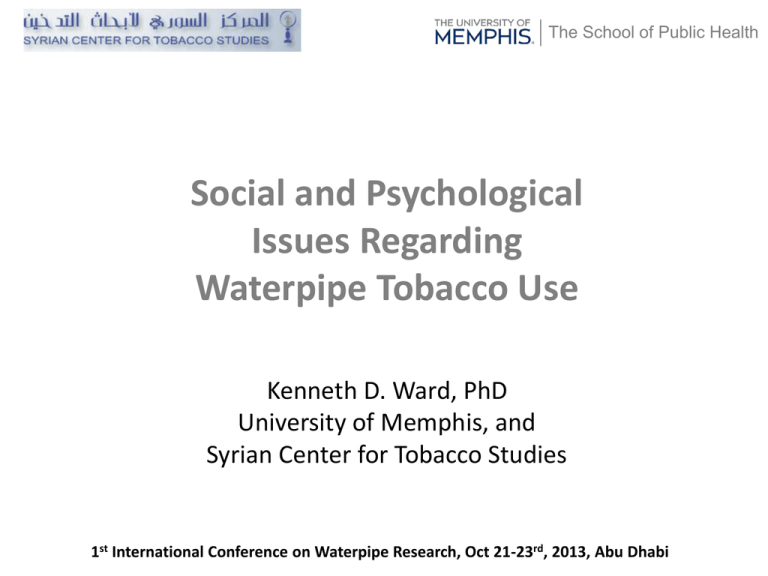
The School of Public Health Social and Psychological Issues Regarding Waterpipe Tobacco Use Kenneth D. Ward, PhD University of Memphis, and Syrian Center for Tobacco Studies 1st International Conference on Waterpipe Research, Oct 21-23rd, 2013, Abu Dhabi Goals • What psychological and social factors encourage initiation and maintenance of waterpipe use? – Motivational factors – Perceptions of health effects – Perceptions of addictiveness – Social factors, including acceptability and availability • Next steps Publications about psychological and social aspects of WP use 50 # Medline citations 45 40 35 30 25 20 15 10 5 0 2002 2003 2004 2005 2006 2007 2008 2009 2010 2011 2012 Promoting Health: Intervention Strategies from Social and Behavioral Research, by the National Academy of Sciences. We have less empirical evidence about determinants of initiation than determinants of maintenance. First use of waterpipe by university students in Aleppo, Syria Men (%) Women (%) Alone 3 0.0 With friends 86 54 With family members 11 46 Maziak, et al., IJTLD, 2004 Why did you start using waterpipe? “It’s a pleasure among friends” Due to the boredom of having free time, I used to go with my friends to a cafe´. When they invited me to try narghile, I found it interesting and good. I felt some dizziness, but I enjoyed the taste and the smell. It was fun. And so I became a daily smoker. Hammal et al., Tobacco Control, 2008 10th graders in Johannesburg, SA • 20% smoke waterpipe daily • Most cited reasons for smoking: – “Nothing better to do” (46%) – “Helps to relax” (28%) – Peer Pressure (14%) • 39% perceived pressure to smoke waterpipe – Addicted (6%) Combrink et al., SAMJ, 2010 Why did you start using waterpipe? “Everyone does it” “…I started smoking narghile in public places. I go out with my friends. They are all [narghile] smokers. I smoke [narghile] with them to entertain myself and because I do not want to be different.” Hammal et al., Tobacco Control, 2008 Sensory characteristics • Smell, taste, sight of smoke, "The strong flavour and strong sound of bubbling sound smoke are great. I can do smoke – Maziak 2004 rings and impress the ladies. – Nakkash 2011 There would be no point in – Roskin 2009 smoking if it wasn't flavoured.” – Smith-Simone 2008 (Roskin & Aveyard, 2009) “.. I like the smoke when it comes out as it does…When I wasn’t smoking the waterpipe, I used to look at someone who smoked it and see how the smoke comes out of it and that made me love it.” (Nakkash 2011) Why did you start using waterpipe? “It’s an affordable novelty” “...we can order it twice, three times...Sharing and if it’s for 10,000 L.L. and we are 3 or 4 [people], so approximately 2000 L.L. per person is affordable” “I think if [the waterpipe was]… expensive relative to the income, it would not be that popular (...); a higher price would deter from use (Woman non-smoker - urban area) Nakkash et al., BMC Public Health, 2011 Social aspects maintain use • “Time with friends,” “communal aspects,” role as a “social lubricant,” promotion of “kinship” and “brotherhood,” relaxation, relief of boredom – Guiliani 2010 – Jamil 2010 – Martinasek 2013 – Maziak 2004 – Smith-Simone 2008 - Roskin 2009 - Anjun 2008 - Al Dabbagh 2005 - Labib 2005 - Ghafouri 2011 Family acceptance, or at least acquiescence "I have never smoked cigarettes in front of my parents. They'd be surprised, annoyed and disappointed. There is something more acceptable about shisha.” "When I explained to my parents it was harmless, they were fine. They've tried it.” Roskin, et al., More family acceptance of WP use for women than men Maziak et al., Ann Epidemiol, 2004 A majority of users believe waterpipe is less harmful than cigarettes • U.S. samples: Abughosh, 2011; Ajiarrah 2009; Giuliani 2010; Jamil 2011; Smith 2011; Smith-Simone 2008; Sutfin 2011; Ward 2007 • Middle East samples: (AlDabbagh 2005; Anjum 2008; Asfar 2005; Chaaya 2004; Erbaydar 2010; Ghafour 2011; Hammal 2008; Jawaid 2008; Labib 2007; Varsano 2003) “I do not worry about narghile. I do not feel it is harmful. It is not more than entertainment. We have not heard about anyone who had a health problem because of the narghile.” (Hammal et al., 2008) Perceived addictiveness • Most users in Middle East and western countries don’t perceive themselves to be addicted (Maziak 2005; Primack 2008; Smith-Simone 2008; Ward 2005, 2007) • Waterpipe is perceived as less addictive than cigarettes, by WP smokers, cigarette smokers, and non-smokers (Abughosh 2011; Azab 2010; Jawaid 2008; Maziak 2004) Which is more addictive? WP users (%) 90 Nonsmokers (%) 77 Cigarettes and waterpipe are equally addictive 8 17 Waterpipe is more addictive 2 5 Cigarettes are more addictive Maziak et al., Ann Epidemiol, 2004 However, many frequent users do believe they are addicted Maziak, et al., Pharm, Biochem, Behav, 2005 Why is waterpipe perceived as less harmful/addictive? • “Filtering” means less nicotine and tar get delivered – “From what I’ve been told, the water acts as a filter to get rid of bad stuff.” – “Water catches the ashes from the charcoal. Not like a cigarette filter, water is a natural filter.” (Roskin & Aveyard, 2009). • Flavor/smell indicate it’s safe (Dillon & Chase, 2010) – “Fruit flavour makes it less harmful. I don’t believe it’s as harmful as cigarettes.” (Roskin & Aveyard, 2009) Why is waterpipe perceived as less harmful/addictive? • “If it’s so bad, why haven’t I heard about it?” • “Cigarettes are much more harmful, as the dangers are publicized. I don’t really see the danger [of smoking waterpipe].” (Nakkash et al., 2009) • “There are no warnings on TV. If there were warnings, I’d be more aware.” (Roskin & Aveyard, 2009) Important to remember that determinants of waterpipe use are not invariant across time, population, and place. Afifi, et al., Eur J Public Health, 2009 • • • • • • • • • Relief of boredom Relaxation Smell Taste Look of pipe Bubbling sound Availability Peer influence Influence of family members • Novelty/experimentation • Affect management (stress, anxiety, depression, anger) • Reduced harm • Reduced addictiveness • Exoticness • Affordability • Way to quit cigarettes • Culturally acceptable alternative to cigarettes • Way to express cultural identity Akl et al., Harm Reduction Journal, 2013 Martinasek, et al., Am J Health Behavior, 2013 Positive attitudes are stronger determinant of intent to smoke WP than negative attitudes Hookah seems… OR 95% CI Attractive 6.49 4.65-9.05 Romantic 4.56 3.21-6.47 Fun 3.46 2.91-4.10 Relaxing 2.67 2.27-3.14 Overall 9.31 6.77-12.80 Harmful 0.98 0.87-1.10 Addicting 0.71 0.63-0.80 Overall 0.79 0.69-0.90 2.12 1.76-2.54 Positive Perceptions Negative Perceptions Socially acceptable Barnett et al., Am J Health Behavior, 2013 Outcome expectancies are related to intent to initiate WP use (n=722 never users) Latent factor Correlation with intent to use WP .61 <.001 Consistent with values (family, religious, cultural, intellectual) .32 <.001 Thrill-seeking .48 <.001 Acute health effects -.30 <.001 Long term effects -.22 <.001 Aids adjustment to college life p Martinasek, unpublished data Many social determinants, but not all, are “available to awareness” of users… • Exemptions from clean air laws (Primack 2012) • Failure to fully enact FCTC: only 7 Arab countries have enacted comprehensive smoking bans in public places, while the rest have partial or no bans and enforcement remains low overall (WHO 2009, reported in Maziak 2013) • Mismatch of FCTC goals with waterpipe – E.g., packaging/labeling is more complicated with WP due to variability compared to cigarettes (Maziak, Nakkash,et al., 2013) Summary • Social nature of WP use (“a pleasure among friends,” relaxation, peer/family influence) is major determinant of initiation and maintenance • Need to “deglamorize and renormalize” WP use (Maziak et al., 2007) • More “upstream” determinants are wide availability promoted by absent/unenforced policies such as clean air laws, inexpensiveness, lack of knowledge of harms due to “research to practice” limitations • Future research should use prospective multilevel approaches to model how intrapersonal, interpersonal, and community/societal level factors jointly influence initiation and maintenance of waterpipe use • But we shouldn’t wait! Thank you! • • • • • • • • Radwan Al Ali, MD Taghrid Asfar, MD Iman Ebrahim Tom Eissenberg, PhD Madonna Elias Fouad Fouad, MD Wasim Maziak, MD, PhD Samer Rastam, MD, PhD www.scts-sy.org
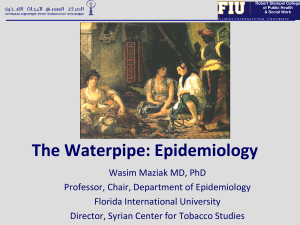
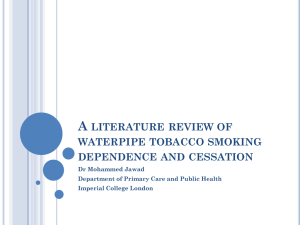
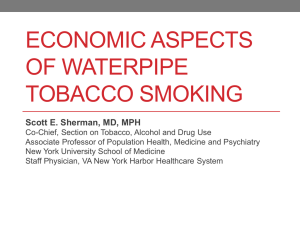
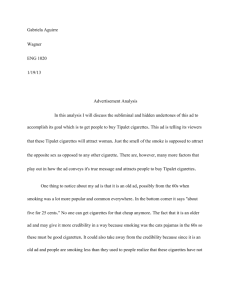
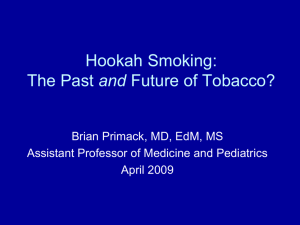

![[document]](http://s2.studylib.net/store/data/015411161_1-b583f9837bc154834e0a705bc5425d26-300x300.png)